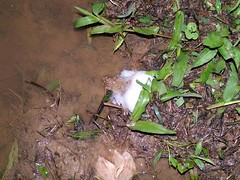Team:Glasgow/Ranaspumin2
From 2011.igem.org
| Line 8: | Line 8: | ||
</p> | </p> | ||
| - | + | <table> | |
| + | <tr> | ||
| + | <td> | ||
| + | <div> | ||
| + | <img src="http://farm7.static.flickr.com/6169/6166704517_2646892173_m.jpg" width="300" height="250" /> | ||
| + | <p> | ||
| + | <font size="1" color="grey> | ||
| + | <i>E. pustulosus</i> forming its foam nest<sup>1</sup></font></p> | ||
| + | </div> | ||
| + | </td> | ||
| + | <td> | ||
| + | <div> | ||
| + | <img src="http://farm7.static.flickr.com/6169/6166704517_2646892173_m.jpg" width="300" height="250" /> | ||
| + | <p> | ||
| + | <font size="1" color="grey"> | ||
| + | A Tungara frog foam nest from Trinidad<sup>1</sup></font></p> | ||
| + | </div> | ||
| + | </td> | ||
| + | </tr> | ||
| + | </table> | ||
<h2>Structure </h2> | <h2>Structure </h2> | ||
<p> | <p> | ||
| - | Coded for by the gene <i>rsn-2</i>, Ranaspumin-2 is a monomeric surfactant protein, with an atomic mass of 11kDa. | + | Coded for by the gene <i>rsn-2</i>, Ranaspumin-2 is a monomeric surfactant protein, with an atomic mass of 11kDa. Ranaspumin-2 (Rsn-2) is a monomeric, 11 kDa surfactant protein identified as one of the major foam nest components of the tungara frog (Engystomops pustulosus), with an amino acid sequence unlike any other protein described so far. Wereport here on its structure in solution as determined by high-resolution NMR analysis, together with investigations of its conformation and packing at the air-water interface using a combination of infrared and neutron reflectivity techniques. Despite the lack of any significant sequence similarity, Rsn-2 in solution adopts a compact globular fold characteristic of the cystatin family, comprising a single helix over a four-stranded sheet, in a motif not previously associated with surfactant activity. The NMR structure of Rsn-2 shows no obvious amphiphilicity that might be anticipated for a surfactant protein. This suggests that it must undergo a significant conformational change when incorporated into the air-water interface that may involve a hinge-bending, clamshell opening of the separate helix and sheet segments to expose hydrophobic faces to air while maintaining the highly polar surfaces in contact with the underlying water layer. This model is supported by direct observation of the relative orientations of secondary structure elements at the interface by infrared reflection absorption spectroscopy, and by protein packing densities |
| - | + | determined from neutron reflectivity profiles | |
| - | + | MW= 13415.2 117 AAs | |
| - | Rsn-2( | + | |
| - | + | ||
| - | + | ||
| - | + | ||
| - | + | ||
| - | + | ||
| - | + | ||
| - | + | ||
| - | + | ||
| - | + | ||
| - | + | ||
| - | + | ||
| - | + | ||
| - | + | ||
| - | + | ||
| - | Rsn-2 | + | |
| - | + | ||
| - | + | ||
| - | + | ||
| - | + | ||
| - | + | ||
| - | + | ||
| - | + | ||
| - | + | ||
| - | + | ||
| - | + | ||
| - | + | ||
| - | + | ||
| - | + | ||
| - | + | ||
| - | + | ||
| - | + | ||
| - | + | ||
| - | + | ||
| - | + | ||
| - | + | ||
| - | + | ||
| + | <a href="2011.igem.org/Team:Glasgow/Ranaspumin2 Sequence> Click here for Ranaspumin2 sequence</a> | ||
Revision as of 20:18, 20 September 2011

Ranaspumin2
Ranaspumin 2 is one of six proteins used by the tungara frog (Engystomops pustulosus, found in Central and South America) to form protein foam nests in which it deposits its eggs. Protein foams are relatively rare in biology, and in this case offer a biocompatible solution to incubation and protection from mechanical destruction, as well as anti-microbial properties.

A Tungara frog foam nest from Trinidad1 |
Structure
Coded for by the gene rsn-2, Ranaspumin-2 is a monomeric surfactant protein, with an atomic mass of 11kDa. Ranaspumin-2 (Rsn-2) is a monomeric, 11 kDa surfactant protein identified as one of the major foam nest components of the tungara frog (Engystomops pustulosus), with an amino acid sequence unlike any other protein described so far. Wereport here on its structure in solution as determined by high-resolution NMR analysis, together with investigations of its conformation and packing at the air-water interface using a combination of infrared and neutron reflectivity techniques. Despite the lack of any significant sequence similarity, Rsn-2 in solution adopts a compact globular fold characteristic of the cystatin family, comprising a single helix over a four-stranded sheet, in a motif not previously associated with surfactant activity. The NMR structure of Rsn-2 shows no obvious amphiphilicity that might be anticipated for a surfactant protein. This suggests that it must undergo a significant conformational change when incorporated into the air-water interface that may involve a hinge-bending, clamshell opening of the separate helix and sheet segments to expose hydrophobic faces to air while maintaining the highly polar surfaces in contact with the underlying water layer. This model is supported by direct observation of the relative orientations of secondary structure elements at the interface by infrared reflection absorption spectroscopy, and by protein packing densities determined from neutron reflectivity profiles MW= 13415.2 117 AAs Retrieved from "http://2011.igem.org/Team:Glasgow/Ranaspumin2"
 "
"
